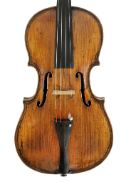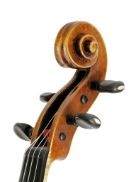Viola, Giovanni Paolo Maggini, Brescia, early 17th century
Not the original printed label: “Gio. Paulo Maggini in Brescia”Until the 17th century, violas were built in two different body sizes. The larger model had a body length of up to 47 cm. Such violas – also referred to as tenor violas – had a very sonorous low register and were intended to cover the tenor range. The smaller violas – later also called contralto violas – were about 40 to 42 cm long, had a higher register, and were also easier to play. As the middle voices became increasingly difficult to play – consider, for example, the string quartets of the Viennese Classical era – this smaller type of viola became widely established. Maggini built both types of models. This viola with its body length of 41 cm is classified as the smaller type. It was probably made after 1610 and is thus one of Maggini’s early instruments.
The typical Maggini body model has wide lower bouts, short C-bouts, and is highly arched. The two-piece belly is made of spruce with regular, medium-wide annual rings that grow wider toward the edges. The two halves of the belly are not from the same log, and the most recent annual ring is dated 1607. The one-piece, slab-cut back exhibits a cloud-like, quilted figure. The ribs have regular, broad flames. By contrast, the pegbox and scroll are fashioned from unflamed wood. The body has very high arching, which is higher in the back. The arching extends very far to the edge and suddenly stops before transitioning to narrow fluting. The f-holes are typical of Maggini’s style: very upright, wide open, and long. The size of the upper and lower oval eyes is nearly identical. The belly and back feature double purfling. The markedly elongated pegbox is topped by a distinctive scroll whose volutes are very regular and deeply undercut horizontally. Maggini left typical, easily visible toolmarks. A light-brown ground is covered by a dark color varnish typical of the early Brescian school. The value of this instrument derives both from its sound quality and from the fact that instruments by Maggini are rarely to be found.






